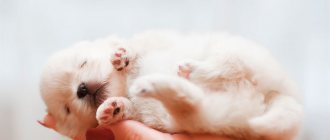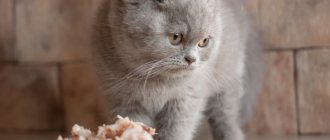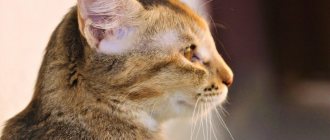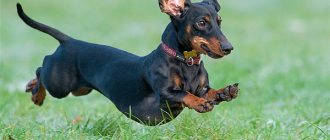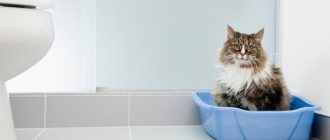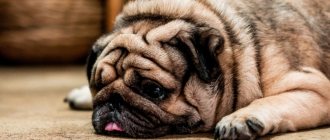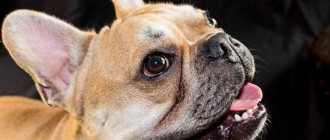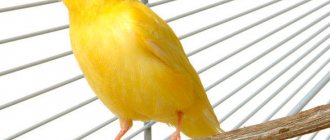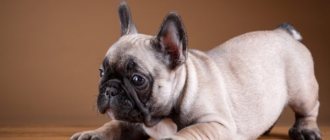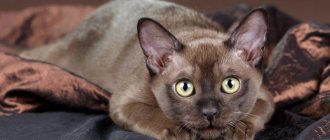Cats are one of the world's favorite pets, but as more of them spend their lives indoors, they're also putting on weight. Obesity can lead to a number of health problems, but most importantly, it shortens their life. If you want to keep your pet healthy but don't know how to tell if he's overweight, we're here to help.
The average domestic cat should weigh (3.6-4.4 kg.
But there are several factors that can change these values, so keep reading as we discuss how to determine the ideal weight for your cat and how to make adjustments so your cat can live a long, healthy life.
We've divided your cat's weight into five categories to help you determine if your cat is overweight and answer the age-old question: "How much should a cat weigh?"
Cat weight categories
Very low weight
Very low weight cats require immediate attention. It is rare to see a cat in this condition unless it is a stray or someone is neglecting it. Very low weight cats will have visible ribs that can be seen from the sides and top. The bones around the tail will not be covered in fat and will be more prominent than normal. The tummy tuck will be extreme and they will usually have little energy for grooming, hunting or playing. If it is a stray, it will lose its fear of people and will approach you in search of food.
Visual inspection
To determine the condition of the animal, it is necessary to carefully examine its physique. The condition of the limbs and abdomen is determined when looking at the profile, the lumbar region and waist are assessed when viewed from above. The weight of a cat can also be “calculated” by manual palpation. To do this, the area of the ribs is felt with your fingers. Moreover, if the bones stick out at the slightest pressure, then the animal is malnourished; if you need to make an effort to palpate them, then, most likely, the pet is obese.
After the ribs, the waist and abdomen area is assessed. In cats, it is very sensitive, so you must be careful when palpating. If you run two palms from the waist to the pelvic bones, you should get an hourglass shape. If this sensation does not arise, then the cat is most likely overweight.
Next, the abdomen is examined. Softness should be felt under your fingers. But if it hangs down a lot or is swollen, then nutritional adjustments are necessary. A sunken belly indicates a lack of nutrition or illness.
Underweight
Underweight cats will have a little more fat than previous types of cats, but not by much. You'll still see the rib bones from the side and they'll be easy to feel when you pet the cat, but they may be harder to see from above.
The bones around the tail will have a soft padding, but they will still be visible and clearly visible, and there will be an excessive tummy tuck. Even though they are underweight and need food immediately, they will still have plenty of energy to hunt and play, and may even want to hide or run away from people when confronted. Most stray cats are underweight, especially if they have a large population or it's winter.
Necessary care
When becoming the happy owner of a 3-month-old Scottish Fold (low-eared) or Scottish Straight (straight-eared), a person must consider the following:
- Quality of licking. The kitten tries hard to get its fur in perfect order, but it does not always have the perseverance to do it efficiently. If the owner helps with cleaning and combing the fur, then you should still teach him to wash the baby’s “buttocks” himself - sometimes lubricate the area under the tail with fish oil or vegetable oil.
- Upbringing. Three-month-old Scots, having just gotten used to it, begin to rush around the house “as if stung,” “attack” the owner’s legs and utter war cries. This is normal behavior for a kitten, but you need to start correcting his behavior - accustom him to a scratching post, discourage him from climbing on the kitchen table and “dining” with indoor flowers. The animal is not beaten or punished - they only scold in a stern voice, show the correct behavior (take it to a scratching post, cat grass), and ignore it for a while.
- Bathing and brushing. Three months is the ideal age to accustom a kitten to grooming and bathing procedures. His psyche is very plastic - the baby will soon get used to these unusual actions. The owner acts calmly, does not shout, speaks kindly, and rewards his efforts with “yummy treats.” It is already very difficult to accustom an adult, wayward “Scot” to such procedures.
- Vaccination. As a rule, the initial stage of the first vaccination remains on the conscience of the breeder. Then the owner brings his lucky acquisition to the veterinarian for an initial examination - the doctor prescribes an anthelmintic. After 10-14 days, the baby will be vaccinated again and a veterinary passport will be issued (if there is no document).
- Fortification. The kitten is actively developing - it does not have enough microelements from food. Therefore, the owner offers the “Scot” vitamin supplements with calcium and taurine. What remedy a particular kitten needs is determined only by a veterinarian.
Obesity
© shutterstock
Like very low weight cats, obese cats require immediate attention. These cats have several health problems, including heart disease, diabetes, kidney disease and more, which shorten their lives. The extra weight will also take a toll on the joints, making it difficult for your cat to climb and jump as usual. The added fat can also make it difficult for your lungs to expand and breathe normally. You may also notice your cat snoring more often. In a fat cat, it will be difficult to feel the ribs and you will see clear fat deposits in the lower back, face and limbs. There will be no visible waist, a very noticeable round belly area with thick fat padding, and the backside will bulge out when viewed from above.
Sequence of administration
When first examining a dog or cat, the veterinarian will pay special attention to the head and neck. The skull should be symmetrical, and the mucous membranes of the eyes should be pink and shiny
The position of the eye in the orbit and the reaction of the pupil to light are assessed. Then the ears are examined. The ear should normally be sensitive to sound. The auditory canal is examined from the outside and inside. Our clinic uses a slit lamp to visually detect eye pathology in an animal. An otoscope is used to examine the ear canal.
When examining the oral cavity, the condition of the mucous membranes, gums, teeth, bite, and the presence or absence of tartar is assessed.
The submandibular lymph nodes are palpated and neck mobility is assessed.
When examining the chest, the integrity of the ribs is checked, the lungs and heart are auscultated, this allows us to identify pathologies of the cardiovascular system and lung diseases. If a patient comes to an appointment with such problems, our clinic has the opportunity to quickly conduct additional instrumental studies (ultrasound of the heart with color Doppler, X-ray).
Palpation of the abdominal cavity is carried out to detect large tumors and identify pain in the internal organs.
In males, the scrotum is examined with mandatory palpation of the testes and penis, and the presence or absence of cryptorchidism is determined. In females, the vulva and mammary glands are examined.
Examination of the condition of the skin - be sure to check the animal for the presence of ectoparasites (fleas, lice eaters), evaluate skin turgor, the presence or absence of pathological molting.
Be sure to examine the front and hind limbs and tail.
At each appointment, thermometry is required: in dogs, the normal body temperature is 37.6 - 39.1 degrees, in cats 38 - 39 degrees.
Cat weight chart
| Physical Traits | |
| Very low weight | ● Dull fur. ● Visible ribs. ● Not soft hoof bones. ● low energy ● Dangerous to life. ● Extreme tummy tuck. |
| Underweight | ● The ribs are visible from the side. ● Padding may obscure ribs when viewed from above. ● Small padding on the tailbones. ● Extreme tummy tuck. |
| Perfect | ● Barely noticeable ribs. ● Soft, underwired ponytail creates a defined hip line. ● Shiny coat. ● Energetic ● Minor tummy tuck. |
| Overweight | ● No visible ribs. ● After the chest, the waist is not visible. ● Round belly with fat pad. ● Slight bulge at the rear when viewed from above. |
| Obesity | ● No visible ribs. ● Visible fat deposits. ● Very clearly rounded belly, thick pad of fat. ● Less energy ● difficulty breathing. ● Dangerous to life. |
Table
Why is the baby overweight and is it dangerous?
At this age, this problem is most often associated with overeating and insufficient physical activity. In most cases, this disorder is diagnosed in domestic cats that do not walk outside.
Most often, the problem of excess weight is solved by reducing portions. As a rule, at 7–9 months, at the height of puberty, the cat’s weight returns to normal. Much less often, obesity becomes a consequence of systemic diseases. To determine whether excess weight indicates pathology, you need to examine the kitten's waist. Normally, the ribs should not be noticeable, but easily palpable. If your fingers “sink” when you feel them, it is difficult for the animal to move, it is lethargic and apathetic, you need to contact a veterinarian.
Source
Ideal cat weight
Many experts recommend that your cat weigh between 4.5 and 5.5 kg, but this is not always the case. The International Cat Association recognizes over 70 cat breeds, and each breed will have different characteristics, including their ideal weight.
Image Credit: Andrew Chan, Flickr
For example, the Singapura cat is one of the smallest cats and you want it to weigh between 2 and 3.5 kg. The Maine Coon is the largest breed, and females will weigh between 5.5 and 7 kg, while males can be even heavier, up to 10 kg.
However, the Domestic Shorthair is one of the most common domestic cats, and unless you have purchased a specific breed, it is probably a Domestic Shorthair. These cats typically weigh around 10 pounds, but this can still vary and you will need to determine the ideal weight for your cat on a case-by-case basis.
Features of kitten growth
Representatives of both the Scottish and British breeds are distinguished by their large and muscular physique. Adult straight-eared and lop-eared individuals weigh between 5–7 kg.
Weight gain is especially noticeable in the first year of an animal’s life. Therefore, at this time the kitten should receive the optimal amount of nutrients and supplements (minerals, vitamins). A balanced diet will allow the kitten not only to develop properly, but also to maintain health at a high level.
Knowing how much a Scottish cat weighs at a given age can help you avoid a lot of problems.
Therefore, it is important to track this indicator during the first year of your furry pet’s life.
Video “Care for Scottish cats”
From this video you will learn about the breed characteristics of Scottish Fold kittens, about care and proper nutrition.
In the first days after birth
The weight of newborn babies of this breed is directly dependent on the size of the litter. The fewer cubs are born, the greater their mass.
A newborn kitten usually weighs in the range from 60 to 140 g. If this parameter goes beyond the limits, this is already a deviation. Although it is necessary to take into account the number of babies in the litter.
Also, the weight of babies depends on the well-being of the mother. If during pregnancy she ate properly, rested well and slept a lot, then the kittens will be healthy and well-fed.
Up to a month
During the first 14 days, babies gain weight very well. Every day they get heavier by 10–20 g
During this period, it is important to monitor the mother’s nutrition, as the kittens feed on her milk. Therefore, her diet should be as balanced as possible. On such mother's milk, the babies begin to grow very quickly
On such mother's milk, the cubs begin to grow very quickly.
Over the course of a week, a small Scots cat normally becomes 100–200 g heavier. By the age of 2 weeks, their weight can be 300–400 g. Females, naturally, will be slightly lighter than males. By the 21st day of life, babies will get stronger and can be introduced to complementary foods. At the same time, mother's milk should still remain the main food product.
For complementary feeding, you should use only high-quality natural products or dry food from special lines designed for growing kittens.
At three months
During the third month, babies continue to gain approximately 100 g per day. By the end of the month, animals can weigh from 800 g to 1 kg. During this period, the kittens are separated from their mother and accustomed to a high-quality diet rich in vitamins and microelements.
Veterinarians advise taking a balanced approach to compiling an animal’s diet at this age. You need to finally decide whether the kitten will eat natural food or dry food.
If natural products were chosen, then each portion is prepared immediately before delivery, which is not always convenient. Therefore, many owners of Scottish cats prefer to feed them high-quality dry food. You cannot combine both approaches in one diet, as this can lead to an imbalance of nutrients, which will negatively affect the health of your pet.
Due to changes in diet, weight gain in young representatives of the Scottish breed slows down during this period.
Up to six months
Starting from the fourth month, kittens become teenagers. At this age they usually weigh about 2 kg. Animals are characterized by mobility and activity. Therefore, they need more vitamins and calories, due to which their intensive growth occurs. In 8 weeks they are able to gain from 500 g to 2 kg. Their body size increases in proportion to weight gain, which does not affect the appearance of the pet in any way.
How to Tell If Your Cat Is a Healthy Weight
The best way to determine if your cat is the right weight is to use our picture guide above and do a visual test. There should be no fat deposits on the cat, but there should be no ribs, especially when looking at the cat from above. He should have a shiny coat that requires frequent grooming, he should have a lot of energy, and he should love to play. His breathing should not seem labored and he should be able to jump fairly easily on high stances.
Cats that are too heavy may have difficulty grooming themselves and may develop mats, especially if they have long hair. He will stop trying to jump on high counters and won't run around as much. His breathing may seem labored, as if his nose is stuffy, and he is more likely to snore. Fat deposits will be visible and especially noticeable when the cat is running.
Symptoms of gastric pathology
The following manifestations may indicate problems in this area:
- pain in the stomach, feeling of fullness, heaviness after eating;
- pain behind the sternum, in the epigastric region;
- difficulty swallowing food;
- feeling of a foreign body in the esophagus;
- belching with a sour taste;
- heartburn;
- nausea, vomiting of undigested food;
- vomiting with blood;
- increased gas formation;
- black stool, bleeding during bowel movements;
- bouts of ravenous hunger/lack of appetite.
Of course, previously identified pathologies of the digestive system are serious indications for gastroenterological examination:
- gastritis;
- reflux disease;
- pancreatitis;
- cholecystitis;
- peptic ulcer;
- cholelithiasis;
- polyps and other formations;
- inflammatory processes;
- oncological diseases, etc.
What to do if your cat is overweight
Unfortunately, helping your cat lose weight is not easy, and it is far preferable to prevent your cat from becoming fat in the first place. Cats can quickly develop fatty liver disease if you try to force them to lose weight too quickly. Fatty liver disease affects your cat's ability to process blood and can be life-threatening.
However, you can follow a few simple steps to help your cat lose weight gradually.
- Feed your cats a quality food with plenty of animal protein and avoid grains. Avoid foods containing corn and soy.
- Feed your cat 3-4 small meals throughout the day instead of giving her food whenever she wants it.
- Spend a few minutes every day playing with your cat to get her more active. Laser pens are a great way to get your cat to run around.
- Take your cat to the vet for a recommendation.
Posted by Christian Adams An American expat living in Metro Manila, Philippines for over a decade, Christian is a lifelong cat lover and the proud father of two rescue cats, Trixie and Chloe. Both girls used to be among the crowds of homeless people who roam the cities and countryside. Three-year-old Trixie was rescued from a litter found under a neighbor's porch, and two-year-old Chloe was brought home by Christian's young son, Henry, who discovered the crying kitten in the parking lot.
Diagnosis of stomach diseases
Diagnosis of stomach diseases is a whole complex of studies, including physical, instrumental, and laboratory methods.
Diagnosis begins with a survey and examination of the patient by a gastroenterologist. Next, based on the collected data, the doctor prescribes the necessary studies.
Instrumental diagnosis of stomach diseases involves the use of such informative methods as:
- gastroscopy (or esophagogastroduodenoscopy, endoscopy);
- Ultrasound of the abdominal organs;
- CT scan;
- fluoroscopy;
- magnetic resonance imaging.
The complex of laboratory methods for diagnosing stomach diseases usually includes:
- general blood analysis;
- blood chemistry;
- general analysis of urine, feces;
- gastropanel;
- pH-metry;
- analysis for tumor markers;
- breath test for Helicobacter pylori.
General blood analysis. This study is indispensable for assessing the state of health in general. When diagnosing gastrointestinal diseases by changes in indicators (ESR, erythrocytes, leukocytes, lymphocytes, hemoglobin, eosinophils, etc.), one can ascertain the presence of inflammatory processes, various infections, bleeding, and neoplasms.
Blood chemistry. The study helps to identify dysfunctions of the gastrointestinal tract, to suspect an acute infection, bleeding or growth of a tumor in the subject.
General urine analysis. Based on characteristics such as color, transparency, specific gravity, acidity, etc., as well as the presence of inclusions (glucose, blood or mucous inclusions, protein, etc.), one can judge the development of an inflammatory or infectious process or neoplasms.
General stool analysis. The study is indispensable in diagnosing bleeding and digestive dysfunction.
Tumor markers. To identify malignant tumors of the gastrointestinal tract, specific markers are used (REA, CA-19-9, CA-242, CA-72-4, M2-RK).
PH-metry. This method allows you to obtain data on the level of acidity in the stomach using flexible probes equipped with special measuring electrodes, which are inserted into the stomach cavity through the nose or mouth.
It is carried out in cases where the doctor needs this indicator to make a diagnosis, to monitor the patient’s condition after gastrectomy, as well as to assess the effectiveness of drugs designed to reduce or increase the acidity of gastric juice.
RN-metry is carried out in a medical facility, under the constant supervision of a doctor.
Gastropanel. A special set of blood tests that helps assess the functional and anatomical state of the gastric mucosa.
The gastroenterological panel includes the most important indicators for diagnosing gastric pathologies:
- antibodies to Helicobacter pylori (these antibodies are detected in patients suffering from gastritis, duodenitis, peptic ulcer);
- gastrin 17 (a hormone that affects the regenerative function of the stomach);
- pepsinogens I and II (the level of these proteins indicates the condition of the mucous membrane of the body of the stomach and the organ as a whole).
Why define?
When a baby is born, one of the first indicators that is noted is its weight. Good weight is the first sign of health. Not the only one, but one of the most important. It's the same with animals. There are weight standards that correspond to each cat breed. Basically they are about the same when the kitten is just born. As adults, norms change. Determining and monitoring weight throughout your pet's life is mandatory. By weight, you can determine overfeeding or underfeeding, an impending or progressive disease, or development.
When born from the same mother, you can compare the weight of kittens even without special instruments. Just looking at them is enough. If the kitten is thinner than the others, then special monitoring is required: behavior, feeding, sleep. If it is visually unclear that the kitten is thinner than the others, then you can watch how he attaches to the breast.
If other, stronger kittens push him away, then you need to take the kitten and bring it to the cat yourself, and more often than the others eat.

